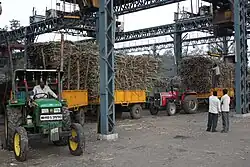Agricultural cooperative
An agricultural cooperative, also known as a farmers' co-op, is a producer cooperative in which farmers pool their resources in certain areas of activity.

A broad typology of agricultural cooperatives distinguishes between agricultural service cooperatives, which provide various services to their individually-farming members, and agricultural production cooperatives in which production resources (land, machinery) are pooled and members farm jointly.[1]
Examples of agricultural production cooperatives include collective farms in former socialist countries, the kibbutzim in Israel, collectively-governed community shared agriculture, Longo Maï co-operatives[2] and Nicaraguan production co-operatives.[3]
The default meaning of "agricultural cooperative" in English is usually an agricultural service cooperative, the numerically dominant form in the world. There are two primary types of agricultural service cooperatives: supply cooperatives and marketing cooperatives. Supply cooperatives supply their members with inputs for agricultural production, including seeds, fertilizers, fuel, and machinery services. Marketing cooperatives are established by farmers to undertake transportation, packaging, pricing, distribution, sales and promotion of farm products (both crop and livestock). Farmers also widely rely on credit cooperatives as a source of financing for both working capital and investments.
Purpose
Cooperatives as a form of business organization are distinct from the more common investor-owned firms (IOFs).[1][4] Both are organized as corporations, but IOFs pursue profit maximization objectives, whereas cooperatives strive to maximize the benefits they generate for their members (which usually involves zero-profit operation). Agricultural cooperatives are therefore created in situations where farmers cannot obtain essential services from IOFs (because the provision of these services is judged to be unprofitable by the IOFs), or when IOFs provide the services at disadvantageous terms to the farmers (i.e., the services are available, but the profit-motivated prices are too high for the farmers). The former situations are characterized in economic theory as market failure or missing services motive. The latter drive the creation of cooperatives as a competitive yardstick or as a means of allowing farmers to build countervailing market power to oppose the IOFs.[1] The concept of competitive yardstick implies that farmers, faced with an unsatisfactory performance by IOFs, may form a cooperative firm whose purpose is to force the IOFs, through competition, to improve their service to farmers.[4]

A practical motivation for the creation of agricultural cooperatives is related to the ability of farmers to pool production and/or resources. In many situations within agriculture, it is simply too expensive for farmers to manufacture products or undertake a service. Cooperatives provide a method for farmers to join in an 'association', through which a group of farmers can acquire a better outcome, typically financial, than by going alone. This approach is aligned to the concept of economies of scale and can also be related as a form of economic synergy, where "two or more agents working together to produce a result not obtainable by any of the agents independently". While it may seem reasonable to conclude that the larger the cooperative the better, this is not necessarily true. Cooperatives exist across a broad membership base, with some cooperatives having fewer than 20 members while others can have over 10,000.
.jpg.webp)
While the economic benefits are a strong driver in forming cooperatives, it is not the sole consideration. In fact, it is possible for the economic benefits from a cooperative to be replicated in other organisational forms, such as an IOF. An important strength of a cooperative for the farmer is that they retain the governance of the association, thereby ensuring they have ultimate ownership and control. This ensures that the profit reimbursement (either through the dividend payout or rebate) is shared only amongst the farmer members, rather than shareholders as in an IOF.
As agricultural production is often the main source of employment and income in rural and impoverished areas, agricultural cooperatives play an instrumental role in socio-economic development, food security and poverty reduction.[5] They provide smallholder farmers with access to natural and educational resources, tools, and otherwise inaccessible marketplaces.[6] Producer organisations can also empower smallholders to become more resilient; in other words, they build the capacity of farmers to prepare for and react to economic and environmental stressors and shocks in a way that limits vulnerability and promotes their sustainability.[7] Research suggests that membership in a producer organisation is more highly correlated with farmer output or income than other standalone investments such as training, certification, or credit.[8]

In agriculture, there are broadly three types of cooperatives: a machinery pool, a manufacturing/marketing cooperative, and a credit union.
- Machinery pool: A family farm may be too small to justify the purchase of expensive farm machinery, which may be only used irregularly, say only during harvest; instead local farmers may get together to form a machinery pool that purchases the necessary equipment for all the members to use.
- Manufacturing/marketing cooperative: A farm does not always have the means of transportation necessary for delivering its produce to the market, or else the small volume of its production may put it in an unfavorable negotiating position with respect to intermediaries and wholesalers; a cooperative will act as an integrator, collecting the output from members, sometimes undertaking manufacturing, and delivering it in large aggregated quantities downstream through the marketing channels.
- Credit Union: Farmers, especially in developing countries, can be charged relatively high interest rates by commercial banks, or credit may not even be available for farmers to access. When providing loans, these banks are often mindful of high transaction costs on small loans, or may refuse credit altogether due to lack of collateral – something very acute in developing countries. To provide a source of credit, farmers can group together funds that can be loaned out to members. Alternatively, the credit union can raise loans at better rates from commercial banks due to the cooperative having a larger associative size than an individual farmer. Often members of a credit union will provide mutual or peer-pressure guarantees for repayment of loans. In some instances, manufacturing/marketing cooperatives may have credit unions as part of their broader business. Such an approach allows farmers to have a more direct access to critical farm inputs, such as seeds and implements. The loans for these inputs are repaid when the farmer sends produce to the manufacturing/marketing cooperative.
Origins and history
The first agricultural cooperatives were created in Europe in the seventeenth century in the Military Frontier, where the wives and children of the border guards lived together in organized agricultural cooperatives next to a funfair and a public bath.[10]
The first civil agricultural cooperatives were created also in Europe in the second half of the nineteenth century. They spread later to North America and the other continents. They have become one of the tools of agricultural development in emerging countries. Farmers also cooperated to form mutual farm insurance societies.
Also related are rural credit unions. They were created in the same periods, with the initial purpose of offering farm loans. Some became universal banks such as Crédit Agricole or Rabobank.
Supply cooperatives
Agricultural supply cooperatives aggregate purchases, storage, and distribution of farm inputs for their members. By taking advantage of volume discounts and utilizing other economies of scale, supply cooperatives bring down the cost of the inputs that the members purchase from the cooperative compared with direct purchases from commercial suppliers. Supply cooperatives provide inputs required for agricultural production including seeds, fertilizers, chemicals, fuel, and farm machinery. Some supply cooperatives operate machinery pools that provide mechanical field services (e.g., plowing, harvesting) to their members.
Examples
France
- Agrial (Normandy)
- Terrena (Pays de la Loire)
- Vivescia
Israel
Korea (South)
Ukraine
United States
- Landisville Produce Co-op, established 1914[11]
- Rockingham Cooperative, established in 1921
- MFA Incorporated
- Darigold
- Organic Valley
- National Council of Farmer Cooperatives
- Southern States Cooperative
- Farmers Cooperative Association, Inc.; Frederick, Maryland
- Ocean Spray (cooperative)
- Land O'Lakes
- Michigan Sugar
- Sunkist
- Wilco stores (Oregon)
- Grange Cooperative
Marketing cooperatives
Agricultural marketing cooperatives are cooperative businesses owned by farmers, to undertake transformation, packaging, distribution, and marketing of farm products (both crop and livestock.)
New Zealand
New Zealand has a strong history of agricultural cooperatives, dating back to the late 19th century. The first was the small Otago Peninsula Co-operative Cheese Factory Co. Ltd, started in 1871 at Highcliff on the Otago Peninsula.[12][13] With active support by the New Zealand government, and small cooperatives being suitable in isolated areas, cooperatives quickly began to dominate the industry. By 1905, dairy cooperatives were the main organisational structure in the industry. In the 1920s–'30s, there were around 500 co-operative dairy companies compared to less than 70 that were privately owned.[14]
However, after World War II, with the advent of improved transportation, processing technologies and energy systems, a trend to merge dairy cooperatives occurred.[15] By the late 1990s, there were two major cooperatives: the Waikato-based New Zealand Dairy Group and the Taranaki-based Kiwi Co-operative Dairies. In 2001 these two cooperatives, together with the New Zealand Dairy Board, merged to form Fonterra. This mega-merger was supported by the New Zealand Government as part of broader dairy industry deregulation,[16] which allowed other companies to directly export dairy products. Two smaller cooperatives did not join Fonterra, preferring to remain independent – the Morrinsville-based Tatua Dairy Company and Westland Milk Products on the West Coast of the South Island.
The other main agricultural co-operatives in New Zealand are in the meat and fertiliser industries. The meat industry, which has struggled at times, has proposed various mergers similar to the creation of Fonterra; however, these have failed to gain the necessary member support.[17]
Canada
In Canada, the most important cooperatives of this kind were the wheat pools. These farmer-owned cooperatives bought and transported grain throughout Western Canada. They replaced the earlier privately and often foreign-owned grain buyers and came to dominate the market in the post-war period. By the 1990s, most had demutualized (privatized), and several mergers occurred. Now all the former wheat pools are part of the Viterra corporation.
Former wheat pools include:
Other agricultural marketing cooperatives in Canada include:
- Organic Meadow Cooperative (organic dairy)
- Gay Lea Foods Co-operative Limited (dairy)
- Agropur
Ecuador
The Amazon region of Ecuador is known for producing world-renowned cacao beans. In the Napo region 850 Kichwa families have come together with help from American biologist, Judy Logback, to form an agricultural marketing cooperatives, Kallari Association. This cooperative has helped increase benefits for the families involved as well as to protect and defend their Kichwa culture and the Amazon rainforest.[18]
India

In India, there are networks of cooperatives at the local, regional, state and national levels that assist in agricultural marketing. The commodities that are mostly handled are food grains, jute, cotton, sugar, milk and nuts[19]
Dairy farming based on the Anand Pattern, with a single marketing cooperative, is India's largest self-sustaining industry and its largest rural employment provider. Successful implementation of the Anand model has made India the world's largest milk producer.[20] Here small, marginal farmers with a couple or so heads of milch cattle queue up twice daily to pour milk from their small containers into the village union collection points. The milk after processing at the district unions is then marketed by the state cooperative federation nationally under the Amul brand name, India's largest food brand. With the Anand pattern three-fourths of the price paid by the mainly urban consumers goes into the hands of millions of small dairy farmers, who are the owners of the brand and the cooperative. The cooperative hires professionals for their expertise and skills and uses hi-tech research labs and modern processing plants & transport cold-chains, to ensure quality of their produce and value-add to the milk.
Production of sugar from sugarcane mostly takes place at cooperative sugar cane mills owned by local farmers. The shareholders include all farmers, small and large, supplying sugarcane to the mill.[21] Over the last sixty years, the local sugar mills have played a crucial part in encouraging rural political participation and as a stepping stone for aspiring politicians.[22] This is particularly true in the state of Maharashtra where a large number of politicians belonging to the Congress party or NCP had ties to sugar cooperatives from their respective local areas.[23] Unfortunately, mismanagement and manipulation of the cooperative principles have made a number of these operations inefficient.[24]
Netherlands
- Coöperatieve Nederlandse Bloembollencentrale (CNB)
- Coforta
- Royal Cosun
- ZON
- FloraHolland
- FrieslandCampina
Ukraine
- Ukrainian cooperative movements
United States
- American Legend Cooperative (mink fur) "Blackglama" brand
- Blue Diamond Growers (almonds)
- Cabot Creamery (dairy)
- Darigold
- Diamond of California (nuts), formerly a cooperative
- Dairylea Cooperative Inc. (Dairy), formerly Dairymen's League
- Dairy Farmers of America
- Edible Garden
- Florida's Natural Growers (citrus fruit)
- Humboldt Creamery (dairy), formerly a cooperative
- Land O'Lakes (dairy and farm supply)
- Maine's Own Organic Milk Company (dairy)
- Michigan Milk Producers Association (dairy)
- Michigan Sugar Company (sugar beets)
- Ocean Spray (cranberries and citrus fruit)
- Organic Valley (organic milk, cheese, eggs, soy, butter, yogurt, snack items)
- Riceland Foods (rice, soybeans, corn and wheat)
- Snokist Growers (pears, apples, cherries)
- Sunkist Growers, Incorporated (citrus fruit)
- Sun-Maid (raisins)
- Sunsweet Growers Incorporated (dried fruit, especially prunes)
- Tillamook County Creamery Association (dairy)
- Lone Star Milk Producers (dairy)
- United Egg Producers
- Welch Foods Inc. (Welch's)
Production cooperatives
These are cooperative farms, jointly owned or managed by a cooperative society.
Cuba
See also
References
- Cobia, David, editor, Cooperatives in Agriculture, Prentice-Hall, Englewood Cliffs, NJ (1989), p. 50.
- "Longo Mai, Costa Rica". Sonador.info. Archived from the original on 15 April 2012. Retrieved 27 December 2011.
- Why Nicaraguan Peasants Stay in Agricultural Production Cooperatives Archived 2012-05-03 at the Wayback Machine Ruerd Ruben and Zvi Lerman
- John M. Staatz, "Farmers' incentives to take collective action via cooperatives: A transaction-cost approach, " in: Cooperative Theory: New Approaches, ed. J.S. Royer, Washington, DC: USDA ACS Service Report 18 (July 1987), pp. 87–107.
- "Agricultural cooperatives: paving the way for food security and rural development" (PDF). Retrieved 17 August 2020.
- "Agricultural cooperatives: paving the way for food security and rural development" (PDF). Retrieved 17 August 2020.
- Serfilippi, E; Ramnath, G (2018). "Resilience Measurement and Conceptual Frameworks: A Review of the Literature". Annals of Public and Cooperative Economics. 89 (4): 645–664. doi:10.1111/apce.12202. S2CID 158989942.
- "Empowering Farmers through Producer Organizations" (PDF). Retrieved 17 August 2020.
- "Understanding Cooperatives: Farmer Cooperative Statistics" (PDF), Cooperative Information, United States Department of Agriculture, Report 45, Section 13, 2011
- Hallberg, Milton C. (2007). References on Agricultural History and Rural Life in the United States: Descriptive Studies, Historical Analyses, Novels on Agricultural Pioneering, and Documentaries. Department of Agricultural Economics and Rural Sociology, Agricultural Experiment Station, The Pennsylvania State University, University Park, Pennsylvania 16802: Milton C. Hallberg. p. 64.
{{cite book}}: CS1 maint: location (link) - "Jersey Fresh produce found at nation's oldest fruit and vegetable co-op". nj.com. 23 July 2015. Archived from the original on 28 October 2017. Retrieved 28 October 2017.
- Petchey, Peter (November 1998). "La crème de la crème" (PDF). Welcome to the Hocken: Bulletins of the Friends of the Hocken Collections (26). Archived (PDF) from the original on 17 May 2011. Retrieved 13 February 2011.
- "Catherine Mathieson". Dictionary of New Zealand Biography.
- Philpott, H.G. (1937). A History of the New Zealand Dairy Industry: 1840–1935. Wellington: Government Printer.
- Ward, A.H. (1975). A Command of Cooperatives. Wellington: The New Zealand Dairy Board.
- Fonterra Co-Operative Group Ltd. Archived 2011-06-14 at the Wayback Machine. Reference For Business.
- Hembry, Owen (14 April 2008). "Meat mega merger hits a bumpy road". The New Zealand Herald. Retrieved 13 February 2011.
- "Our Mission". Kallari.com. Archived from the original on 6 February 2015. Retrieved 6 February 2015.
- Vadivelu A, Kiran BR (2013). "Problems and prospects of agricultural marketing in India: An overview". International Journal of Agricultural and Food Science. 3 (3): 108–118. S2CID 4864110 – via Scribd.
- Scholten, Bruce A. (2010). India's white revolution Operation Flood, food aid and development. London: Tauris Academic Studies. p. 10. ISBN 978-1-4416-7658-0. Archived from the original on 2018-05-03.
- "National Federation of Cooperative Sugar Factories Limited". Coopsugar.org. Archived from the original on 5 February 2012. Retrieved 27 December 2011.
- Patil, Anil (9 July 2007). "Sugar cooperatives on death bed in Maharashtra". Rediff India. Archived from the original on 28 August 2011. Retrieved 27 December 2011.
- Lalwani, Mala (2008). "Sugar Co-operatives in Maharashtra: A Political Economy Perspective" (PDF). The Journal of Development Studies. 44 (10): 1474–1505. doi:10.1080/00220380802265108. S2CID 154425894. Archived from the original (PDF) on 2014-01-17.
- "Archived copy" (PDF). Archived (PDF) from the original on 2015-09-24. Retrieved 2015-09-28.
{{cite web}}: CS1 maint: archived copy as title (link)
Further reading
- McBride, Glynn (2014), Agricultural Cooperatives: Their Why and Their How
- Derr, Jascha (2013), The cooperative movement of Brazil and South Africa
- Zvi Galor